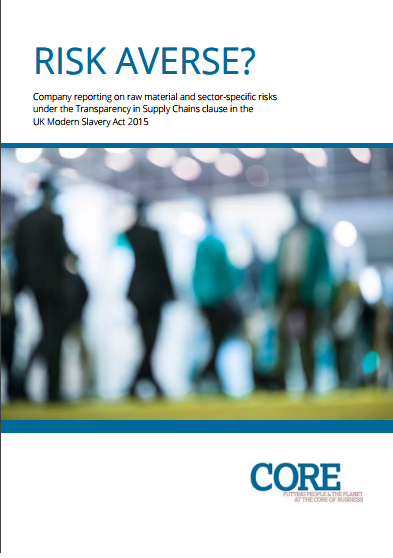EXECUTIVE SUMMARY
Background
Section 54 of the Modern Slavery Act 2015, the Transparency in Supply Chains Reporting clause requires all commercial organisations with an annual turnover of more than £36 million operating in the UK to publish a Slavery and Human Trafficking Statement. Section 54(5) of the Act describes the information that may be included in a statement:
- the organisation’s structure, its business and its supply chains;
- its policies in relation to slavery and human trafficking;
- its due diligence processes in relation to slavery and human trafficking in its business and supply chains;
- the parts of its business and supply chains where there is a risk of slavery and human trafficking taking place, and the steps it has taken to assess and manage that risk;
- its effectiveness in ensuring that slavery and human trafficking is not taking place in its business or supply chains, measured against such performance indicators as it considers appropriate;
- the training and capacity building about slavery and human trafficking available to its staff.
The reporting requirement commenced on 29th October 2015 and it is estimated that between 12,000 and 17,000 companies are within its scope. The Home Office recommends that companies report within six months of their financial year end and as businesses with a year end of 31 March 2016 were the first in line to comply, accordingly all companies covered by the requirement should have reported by the end of September 2017. At the time of writing, just over 3,000 statements were available on the Modern Slavery Registry website.
The report
The objective of this report is to provide a snapshot of company Slavery and Human Trafficking Statements published in compliance with the TISC clause. The authors chose to focus on companies that produce or provide products and services which reach a large number of customers and/or other businesses, and to complement the Business & Human Rights Resource Centre’s analysis of FTSE 100 statements by looking at smaller companies, those listed on other exchanges and private firms.
The report’s focus is companies who source raw materials associated with a heightened risk of modern slavery – cocoa from West Africa, mined gold, mica from India, palm oil from Indonesia, and tea from Assam – and companies operating in sectors that are widely recognized as being at heightened risk: garment production; hotels and accommodation; construction; football clubs (which due to the nature of their businesses include a wide range of functions including hospitality and retailing manufactured goods); and outsourcing companies. The authors look at 50 companies’ Slavery and Human Trafficking statements; 25 from companies sourcing raw materials, five each under each material; 25 from at-risk sectors, five from each sector.
The authors explore if and how companies include information on the particular raw material and sector-specific risks in their statements, looking particularly at the description of their operations and supply chains and their due diligence. These areas correspond broadly with points (a), (c) and (d) of the Act. The authors also looked for relevant information in other documents available on the companies’ websites, for instance Codes of Conduct. The authors were interested in the extent to which companies are making connections between the risk of slavery and human trafficking, wider labour rights issues (such as wages and working hours) and economic factors, most notably the price paid for raw materials.
The report itself does not allege directly that any of the named companies have slavery or human trafficking in their operations or supply chains.
Findings
As the deadline approaches for companies to publish transparency statements under the Modern Slavery Act, overall compliance with the reporting requirement is low, with an estimated 9,000-14,000 companies still to publish.
This report explores a very small sample (less than 2 per cent) of published statements from larger, well-known companies. In general, the authors find that The authors many of these statements are not compliant with the basic requirements of the legislation and that the majority do not address in substantive detail the six topic areas listed in the Act. This is despite the fact that relevant information, relating for instance to source countries for raw materials is often provided in other documents available on company websites. Many companies are not reporting on human rights due diligence and are not considering how their own business models can create risks of severe labour rights abuses.
The Modern Slavery Act has been described as a potential game-changer on supply chain transparency, but this will only be achieved with a considered and concerted effort across the private sector. As we move into the next year of reporting, companies have an opportunity to be open about the issues, to learn from good practice and to work together to drive real change.

